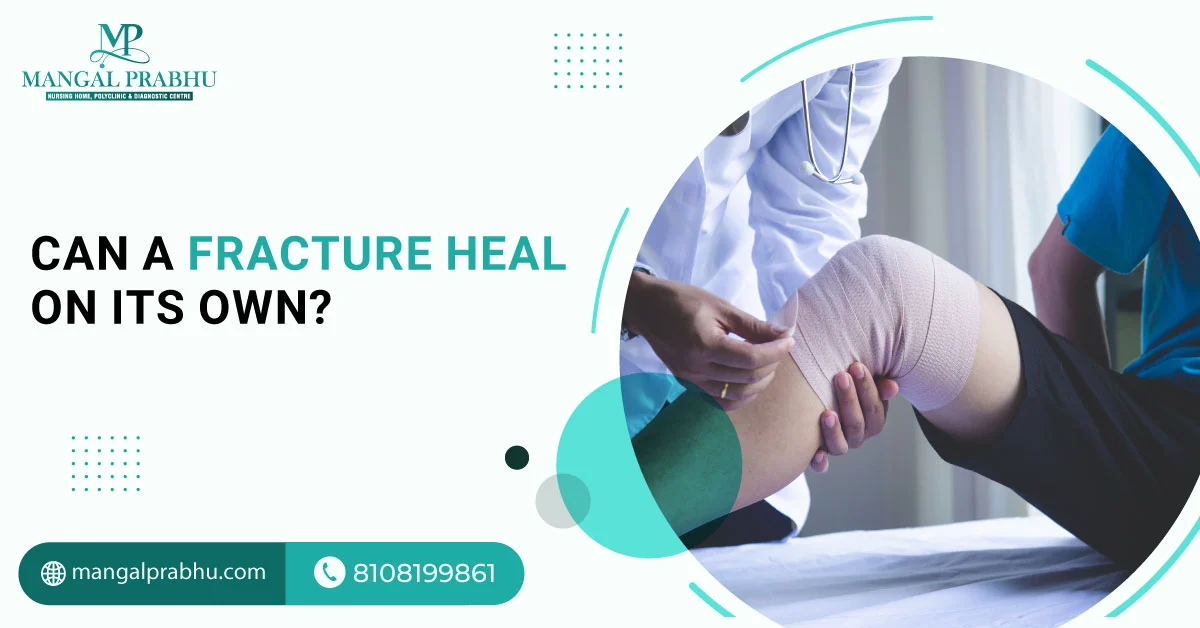
Can a Fracture Heal On Its Own?
Can a Fracture Heal On Its Own?
Our bones have limited flexibility. They can handle pressure only to a certain extent. When exposed to a significant force, they might fracture. While it’s obvious that a severe fracture requires an immediate visit to the orthopedic hospital in Navi Mumbai, people often wonder if mild fractures can heal on their own.
Fractures can often be healed with home remedies. However, this applies only to certain types of fractures. Let’s discuss it in detail:
a) Types of Fractures
A bone fracture is when your bone breaks partially or completely. It may vary in severity, depending on how forcefully your bone got hit. Here is the classification of bone fractures:
i) Simple Vs. Compound Fractures:
In a simple fracture, your bone cracks but does not break through the skin. The fracture isn’t severe enough to cause a deep wound. A compound fracture punctures your skin.
ii) Stable Vs. Unstable Fractures:
In a stable fracture, the broken parts of the bone do not get misaligned, while an unstable fracture causes the misalignment and the risk of further damage to the nearby ligaments.
It’s obvious that compound and unstable fractures require medical attention, while the simple fractures that do not cause any dislocation or skin wound can heal on their own.
b) Natural Healing Process
The timeline for recovery from a bone fracture may vary from person to person. A simple wrist or hand fracture might heal in 6 weeks, but the broken tibia can take up to 20 weeks to heal completely. Here’s the breakdown of the recovery phases:
c) Inflammation
Your body’s inflammatory response activates as soon as you have sustained a bone fracture. Due to the damage to the tissues and blood vessels, bleeding starts and the blood pools around the broken ends of the bone. This blood thickens and turns into a clot.
The dead cells die and are cleaned up from the site. During this phase, you will notice swelling and sharp pain. These are the signs that you are in the inflammatory phase of healing. It lasts 1-2 weeks.
d) Repair Phase
Once the dead cells are removed, your body will work hard to rebuild the new structure. It builds new cells, cartilage, and fibrous tissues. They all form a fracture callus, a soft patch where calcium deposits. It becomes harder to form a new, stabilized bone.
e) Remodeling
At this point, the fracture callus hardens, and the new bone starts forming. The progress is visible on an X-ray. You won’t feel the pain, swelling, and inflammation like before. However, the remodelling might go on for several months.
When Medical Intervention is Necessary
Unfortunately, not all fractures have a simple healing process. Here’s when you need to see a doctor for bone fracture treatment in Navi Mumbai:
- The bone has shattered into multiple pieces and has wounded your skin
- You have diabetes or other medical issues.
- The X-ray shows bone dislocation
Ideally, it’s best to consult a doctor to know whether the fracture is severe enough to require medical attention. Based on your symptoms and reports, you may need a cast, brace, or surgical treatment.

Signs and Symptoms of a Fracture
A crack in your bone due to trauma or stress can lead to a fracture. People diagnosed with osteoporosis and bone cancer are also at an increased risk of developing fractures. Depending on the severity of the trauma, a fracture could be closed (the bone cracks but doesn’t break through your skin) or comminuted (the bone breaks into multiple pieces). If you suspect a fracture, get to the nearest orthopedic hospital in Navi Mumbai for the best care.
Common Causes of Fractures
i) Accidents and falls:
Healthy bones are strong enough to withstand pressure effortlessly. However, if you experience a serious fall or an accident that puts a great deal of force on your bones, they might break.
ii) Sports injuries:
Sports that require a lot of twisting and turning can cause fractures. People involved in sports can develop spiral, transverse, comminuted, hairline, and stress fractures.
iii) Osteoporosis and bone weakening conditions:
With age, your bone density and resilience decrease significantly, making you more prone to sustaining a fracture even with low-impact trauma.
Signs and Symptoms of a Fracture
a) Pain and tenderness:
Intense pain on the injured site is the hallmark symptom of a fracture. It’s your body’s way of telling you that something isn’t right and requires medical attention. People with fractures might feel pain when touching the site, moving it, or putting weight on it. It may not get better with rest.
b) Swelling and bruising:
The tissue damage can cause swelling, which won’t go down. You might also notice bruising (your skin turning blue, purple, or yellow) that indicates bleeding under your skin.
c) Deformity or abnormal appearance:
Fractured bone appears deformed, as the bone breaks and causes a significant misalignment. In some cases, the bone may pierce through the skin, which makes its deformity pretty obvious.
d) Inability to move or bear weight:
Bone fractures are extremely painful. The pain, combined with swelling and nerve damage, can restrict your movement. You won’t be able to lift weights or perform any physical activity until the bone gets back in shape.
Types of Fractures
Fractures are classified into different types based on the severity of the wound.
1) Simple vs. compound fractures:
In simple fractures, your bones crack but do not penetrate the skin. So, there’s no visible open wound. Compound fracture does penetrate the skin and requires immediate medical care.
2) Stress fractures:
It refers to a small crack in your bones caused by repetitive movements or overuse of your bones.
3) Greenstick and comminuted fractures:
Greenstick fractures are more likely to occur in children, as they have soft, flexible bones. The bone bends and cracks slightly without breaking completely. Comminuted fractures are more severe and are often caused by a serious fall or an accident. In this, the bone breaks into multiple pieces. You must see a fracture treatment doctor in Navi Mumbai if there’s a noticeable deformity combined with excruciating pain and a severe misalignment of the bones after an injury. Medical treatment is specifically required if the pain persists and you experience restricted movements.
